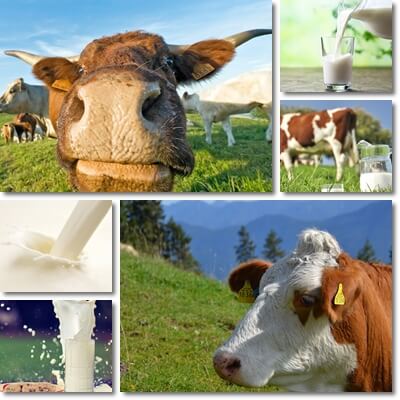There’s 3.25%, there’s 2% and then there’s 1% milk. There’s also 6% and 1.8% and 0.1% as well as several other numbers in-between. But what do these percentages actually mean for your health and how exactly do they affect the nutritional value of the milk you choose to drink every so often? Can the partial or total removal of butterfat from milk have that much of a health effect or is it just not life-changing? Find out just how different milk is according to fat content and what this means in fact for your nutrition and health:
1) Whole milk
By definition, it refers to milk that retains all of its original fat content (or butterfat). Now, some cattle produce higher butterfat milk than others, which accounts for the different definitions of whole milk in various countries. The choice for fat content in whole milk is country specific, depending on the dairy cattle grown in the area. At present, Jersey and Guernsey are the commercial dairy cattle to provide high butterfat milk (typically over 4.8 to 5%).

What percent is whole milk? 6%, 5.4%, 4%, 3.6%, 3.5% and 3.25% butterfat milk may all be labelled as whole milk. Whole milk may be raw or pasteurized, although some countries do not permit the sale of raw milk for food safety concerns. Ultra-pasteurization (UHT) is a procedure that heats milk at high temperatures for bursts of up to 15 seconds to destroy bacteria and prolong shelf life for up to several months. As long as the product is kept in its package, seal unopened, there is no need for refrigeration.
Commercially available whole milk is also usually homogenized, meaning it’s processed so that the fat in it does not separate from the rest of it and raise at the top (as it normally does if let to sit for some time). Homogenization is a purely mechanical process that involves high-pressure procedures that break down the fat globules into smaller pieces so that they better disperse through the milk (creating a more uniform texture that prevents the fat from rising to the surface).
Homogenized milk tastes differently in the sense that it has a more uniform and smooth texture, but at slightly blander, yet delicately sweet taste. Unhomogenized raw whole milk has a richer, fattier taste and a less uniform texture (you can taste the slightly larger fat globules adhering to one another and forming patches of a creamy film of milk fat). Depending on where you’re at, whole milk may be raw or pasteurized, raw and homogenized, pasteurized and homogenized or not.

2) Low-fat milk
Depending on the country and their internal regulations, low-fat milk may be anything below 3-3.5%, usually: 2%, 1.8%, 1.5% or 1%. It is usually pasteurized for a longer shelf life and to eliminate bacteria and other microorganisms that could spoil the milk and cause disease. It is also commonly homogenized for a more uniform taste and to prevent the butterfat separating and rising at the surface. It is one of the preferred choices by people looking to improve their diet as the reduced fat content is promoted as a source of health benefits primarily for the cardiovascular system.
Reduced-fat options are directed at anyone needing or looking to lose weight, maintain a stable weight or lower cholesterol levels, whether independent of or associated with various medical conditions. However, it’s important to understand that this is only one step towards a healthier diet and better overall health and addressing other problematic factors, whether dietary (excess calorie intake, eating too many carbs, sugar etc.) or lifestyle-related (lack of physical activity, smoking, pollution), is imperative for achieving health-related goals.
Whole milk vs 2% important nutrition facts:
The main difference between low fat milk such as 2% and whole milk in terms of nutritional value is the obvious reduced fat content. More exactly, the milk fat is removed completely, then part of it is reintroduced so that the end percentage of fat is exactly 2% of the milk. Along with fat, healthy Omega-3 and Omega-6 fatty acids are also removed, depriving the milk of its benefits for the nervous system, heart and cardiovascular system (see benefits of Omega-3).
Furthermore, the lower the fat content, the higher the lactose content which means that regular low-fat options such as 2%, 1.8%, 1.5% or 1% are more likely to trigger lactose intolerance symptoms compared to whole fat options (see difference between regular, low-lactose and lactose-free milk).
Another difference between 2% vs whole milk is the vitamin content. Fat-soluble vitamins A, D, E and K are contained in the milk fat (vitamin K, for example, is found only in trace amounts). As you remove the fat, you also remove these vitamins and the lower the fat content, the lower the amount of these vitamins. To counteract for this deficit, some producers make up the difference through fortification, meaning they add these vitamins themselves (and sometimes others too).
In some parts of the world, fortification more than makes up for what is removed in the sense that it adds more of the fat-soluble vitamins than there were initially in the whole milk (usually vitamin D, sometimes also vitamin A and more rarely vitamin E). But you need fat to absorb these vitamins, not just provide them, which means a certain percentage of fat is required to actually make use of the vitamins.
3) Non-fat or skim milk
Non-fat is more often than not a very low-fat milk. Ranges of fat percentages allowed in skim milk are 0.1% to 0.5%, although some claim a 0.0% percentage. While it is often the go-to choice for those overly health-conscious, it actually provides less nutrition overall, unless fortified. It is usually pasteurized and homogenized.
Skim milk vs whole milk nutrition
Such a low fat content means there is virtually nothing of the healthy vitamins A, D, E and K or Omega-6 and Omega-3 fatty acids, Omega-7 and Omega-9. No saturated fatty acids either. A lower fat content means a higher lactose content which may be problematic for anyone experiencing milder forms of lactose intolerance (those with severe conditions are likely already drinking low-lactose or lactose-free types).
The biggest concern with whole milk is with the adverse health effects of the fat in it. But as studies who, if consumption is moderate and suited to individual nutritional requirements, drinking whole milk alone does not contribute to weight gain or cardiovascular disease, despite it having saturated fatty acids and cholesterol. On the contrary, it helps combat weight gain gain by providing satiety and reducing carbohydrate intake as a result, contributes to sustained energy levels which support an active lifestyle and optimizes the absorption of vitamins A, D, E and K in addition to providing them. Other benefits of whole milk include: supports brain and nervous system health, holds anti-inflammatory properties and benefits for cardiovascular health, including contributing to a healthier cholesterol profile thanks to Omega-3 and Omega-6 fatty acids.
